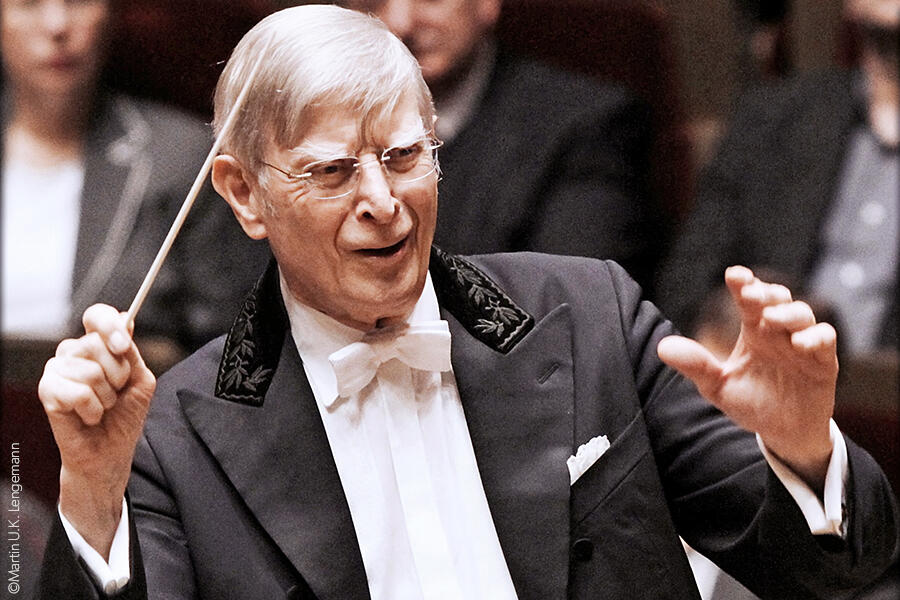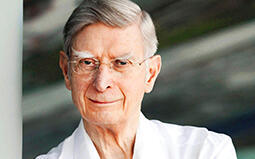- Home
- Concerts
- Subscription Concerts 2023-2024
- Program A
- [Canceled]No. 1992 Subscription (Program A)
Subscription Concerts 2023-2024Program A
[Canceled]No. 1992 Subscription (Program A)
NHK Hall
Google Map Seating Chart

Program
Bruckner / Symphony No. 5 B-flat Major
Music history is long on anecdotes about child prodigies. Bruckner, however, was a late bloomer. Born near Linz in Upper Austria, he made a living as a schoolteacher and church organist before moving to Vienna in 1868 in his mid-forties. It is only from that moment that most of his representative works including Symphonies No. 2 to No. 9 were penned. He had to long put up with cold treatment of his symphonies until the 1884 successful premiere of No. 7 spread his fame widely, twelve years before he passed away in Vienna at age 72.
Constant and inventive harmonic change, massive sound, frequent general (long) pauses evoking a cathedral’s long reverberation, fine command of counterpoint (polyphony) – these qualities making Bruckner’s symphonies extraordinary have to do with the fact that he was an unequaled organ virtuoso (namely an excellent improviser). As for No. 5, he wrote it from 1875 to 1878. As he never revised it after, the situation is much simpler than his other symphonies’ with many different versions and editions mostly owing to his frequent large and small modifications. A main reason for that is that Bruckner never heard No. 5 performed by orchestra. He couldn’t even assist its long-awaited 1894 premiere due to illness which would kill him two years later. For this concert, his pupil Franz Schalk radically changed the orchestration and made numerous cuts to conduct it. Only this unfaithful version was known to public for years, before the International Bruckner Society published the critical editions (based on Bruckner’s manuscripts) by Robert Haas in 1935 and Leopold Nowak in 1951 (which have no significant differences). For today’s performance, Herbert Blomstedt and the orchestra will use the Nowak edition.
Bruckner used in No. 5 a tuba for the first time (prior to the revised version of No. 4), which gives gravity to the sound despite the comparatively compact instrumentation. The global coherence of this monumental work is ensured by the careful design. The outer movements both in B-flat major share the same beginning (pizzicato by cellos and contrabasses in pianissimo). The inner movements both in D minor start with the common string melody with pizzicato triplets. The third movement in A–B–A form has a scherzo (A) in sonata form, of which the cheerful second theme like “Ländler” (Austrian rural dance) reappears in the last movement. This finale gives flashbacks of the previous movements (as with Beethoven’s Ninth) at the slow introduction, followed by a startling amalgam of the sonata form and two fugues. As soon as the exposition starts, the strings powerfully give the first fugue on the first sonata theme. Then, after the brass blows abruptly a new chorale-like element to end the exposition, comes the “double” fugue on this chorale-like element and the first fugue’s theme (that is, the first sonata theme). This grand fugal movement shows the true worth of Bruckner particularly as a supreme master of counterpoint.
[Kumiko Nishi]
Artists
 ConductorHerbert Blomstedt
ConductorHerbert Blomstedt
Swedish conductor Herbert Blomstedt was born in the U.S. in 1927. After studying at various music institutions, including the Stockholm Royal College of Music, he made his debut in 1954 conducting the Stockholm Philharmonic Orchestra. He has served as Music Director or Principal Conductor of the Staatskapelle Dresden, San Francisco Symphony Orchestra, NDR Sinfonieorchester (now NDR Elbphilharmonie Orchester) and the Gewandhaus Orchestra Leipzig while making guest appearances with the world’s most renowned orchestras including the Berliner Philharmoniker and Wiener Philharmoniker.
He first worked with the NHK Symphony Orchestra in 1981, and was made Honorary Conductor of the orchestra in 1986. Since 2013, he has returned to the orchestra’s podium every season except that of 2020–21 when a strict border control was in place due to the COVID-19 pandemic, and in 2016, he was presented the title of Honorary Conductor Laureate. Last year, he conducted programs including Mahler's Symphony No. 9 and won great acclaim. He always takes a sincere attitude when interpreting scores, but the music he delivers is highly sophisticated, exhilarating and crystal clear without having any constraints.
This year marks the 50th anniversary since he first visited Japan as the conductor to lead the Japan tour of the Staatskapelle Dresden in 1973. The programs on this visit contain works of composers he has been most noted for, such as Bruckner, Brahms, and those of his native Scandinavia such as Finnish composer Sibelius and Danish composer Nielsen, and I am sure rich and brilliant music will be welling up from the long-standing and warm relations of mutual trust with the NHK Symphony Orchestra like an endless fountain.
[Kotaro Yamazaki, music critic]
Download
Ticket
Program A
[Canceled]No. 1992 Subscription (Program A)
NHK Hall
Google Map
Seating Chart
Single Tickets Release Date
Pre-sales for Subscribers:Thursday, July 27, 2023
*about subscribers
Sale to General Public:Sunday, July 30, 2023
Price
| S | A | B | C | D | E | |
|---|---|---|---|---|---|---|
| Ordinary Ticket | 9,800 | 8,400 | 6,700 | 5,400 | 4,400 | 2,800 |
| Youth Ticket | 4,500 | 4,000 | 3,300 | 2,500 | 1,800 | 1,400 |
Seating chart Enlarge Print PDF
*tax included
*Subscribers receive a 10% discount (Available at NHKSO WEB Ticket and N-Kyo Guide)
*For wheelchair-accessible seats, please refer to the N-Kyo Guide
Youth Tickets
Youth Tickets are great options for those of 25 years old and younger
Subscription tickets
Release Date
ANNUAL SUBSCRIPTION TICKETS/
SEASONAL SUBSCRIPTION TICKETS (AUTUMN)
Mon., July 17, 2023 10:00am
[For Subscribers: Sun., July 9, 2023 10:00am]
For further information and
subscription application
Other Ticket Agents
*Repertoire, conductor, soloists and program order are subject to change without notice.
*Pre-school children are not allowed in the concert hall


